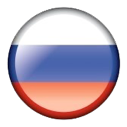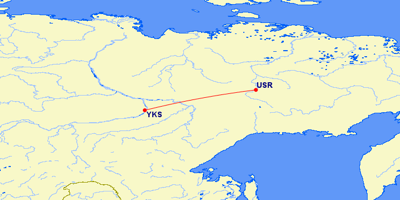From Houston to Sydney 2013

Russian Far East - 2014

I had a much needed and very welcome good sleep last night, sleeping almost ten hours. The airline eye patches worked.
After yesterday’s lovely weather in Ust-Nera, it was something of a rude shock to look out the window and see low grey clouds and wet ground. The rain and the cold weather had returned with a vengeance. It was as though this year’s summer in Ust-Nera had lasted all of one afternoon.
Breakfast was in a small café across the street from the hotel, and comprised boiled eggs, white crumbly bread, butter, cheese and tea or coffee. It was simple but certainly adequate.
At a little after 10:00am, we loaded our bags onto two minibuses, climbed in and headed for Ust-Nera Airport, a short drive of just ten minutes. Ust-Nera airport would be classified as a small regional airport. It has a gravel airstrip and a small building that functions as both offices and terminal for the three flights per week it serves (all to Yalutsk). Despite its small size, it did manage to have an old airliner on display as a monument at its entrance, an Antoniv An-24 of Sakha Airlines. What was once a monument how seemed to have subsequently become a source of spare parts, however, as several pieces (including the propellers) had been cannibalised.
We were scheduled to fly on a Yakutia Airlines Antonov An-140, a small Ukrainian feeder turboprop. However, an unexplained substitution meant we flew instead on a Polar Airlines Antonov An-24, a much older Soviet-era aircraft (and of the same type and vintage as the old plane on display in front of the terminal building). In fact, the aircraft on which we flew today (RA-47352) was manufactured in 1976, making the plane 38 years old.
Polar Airlines have an unusual but strangely effective bag policy. Passengers carry their own suitcases out to the aircraft as they board, lifting it up to a baggage handler standing inside the aircraft who takes the luggage and stores it in the cargo area at the front of the plane. At first, I thought this was just the system for Ust-Nera Airport because of its small size, but the same process was used for unloading the bags when we reached the much larger Yakutsk Airport after the two-hour flight. Everyone collected their luggage at the side of the plane, then boarded the bus (with their luggage) to the terminal, and walked straight out to the street – no waiting for luggage or wondering about lost bags here!
The drive from the airport to our hotel took just 15 minutes, and I was immediately impressed by what I could see of Yakutsk from the minibus window. Yakutsk is clearly a more vibrant city than any other place I had visited so far on this trip. There was a large amount of new buildings under construction, many with quite innovative and creative designs. The people were well dressed in colourful, fashionable clothes, the cars were modern and well-maintained, and there was a general buzz in the atmosphere of the city – something that was confirmed as I undertook two long walks later in the afternoon.
Our hotel, the Hotel Lena, was by far the best hotel we have stayed in so far. Centrally located on Lenin Prospekt (always the best street address in a Russian city), the rooms were bright and clean, there was hot water, a good bed, an affordable restaurant (though with menus only in Russian – thank goodness for my Word Lens app on the phone!), and there was even hot and cold bottled water available free of charge in the corridors. Having wi-fi available was a special bonus, slow and unreliable though it often proved to be.
An introductory lecture had been arranged for us 3:30pm, which left me an hour and a half for a preliminary walkabout the city. I spent an hour of that time walking around. From the hotel, I walked south-west along Lenin Prospekt, past a fascinating and eclectic mix of Soviet-era and brand-new buildings to Lenin Place, a large open square dominated by a huge statue of – well, you know who without my telling you.
After spending a little time photographing Lenin and his square, I proceeded towards the south-east past the Transfiguration Church and a memorial to the Russian Civil War of 1918-1923, and then walked across the street to a large monument dedicated to Pyotr Beketov, the founder of Yakutsk. The weather during the walk was wonderful, with blue skies (punctuated by some scattered but large clouds) and a balmy 24 degrees Celsius. We were later told that the rain in Yakutsk had recently been so heavy that many of the streets had been flooded until yesterday – for once, we seemed to have caught a break on the weather front.
I returned to the hotel at about 3:00pm and ordered a chicken soup for lunch (thank you Word Lens) before heading up to the 6th floor conference room for the 3:30pm lecture. This proved to be an excellent presentation by a History professor from the university in Yakutsk. Among the more interesting points he made were the following:
-
•Yakutsk is an extremely isolated city ‘in the middle of nowhere’ with a strongly continental climate, with summer temperatures reaching 40 degrees Celsius and winter temperatures plummeting to -70 degrees Celsius (although -50 to -55 is more common). Interestingly, winter is the main tourist season in Yakutsk.
-
•Yakutsk was founded in 1633, making it easily the oldest city in the Russian Far East. By 1917, its population had grown to 10,000 people, but it developed rapidly under Stalin as industrialization occurred, and the population grew by 500% between 1926 and 1939. Today, the population is 350,000 people.
-
•Yakutsk is so isolated, and the surrounding Yakutia region is so vast, that the local people use their own measure of distance called the ‘kirs’, which is 10 kolometres. Thus, rather than saying that Ust-Nera is 800 kilometres from Yakutsk, they say it is 80 kirs. The origin of the word kir is that it represented the time it took to cook meat in soup, which was about 30 minutes, and thus a kir was originally the equivalent of 30 minutes driving time.
-
•Yakutsk used to comprise mainly wooden buildings, but they were easily destroyed by fires and permafrost (Yakutsk is built entirely on permafrost, which is more than 50 metres thick, although the upper three to four metres melts each summer before re-freezing in winter). Under the rule of Peter the Great, Yakutsk thus became the only exception to the general law prohibiting the construction of stone buildings outside Saint Petersburg. Today, most of the buildings in Yakutsk are made with concrete and built on stilts, a construction technique that was pioneered in Yakutsk.
-
•The population of Yakutsk comprises about 40% Yakut people, about 40% Russians, with the remaining 20% a broad mix.
-
•Moslems have problems celebrating Ramadan if it falls in summer because the time between sunset and sunrise is so short.
-
•The main industries in Yakutsk are agriculture (cattle raising, pig raising, horse raising [for milk and meat], some vegetable cultivation, barley, oats, rye, sunflowers and corn), mining (diamonds, gold, coal), oil and natural gas. Most of the natural gas is exported to China, while most of the coal is exported to South Korea.
The lecture provided an excellent introduction to Yakutsk, and certainly whetted my appetite for the following day’s explorations.
After the lecture, I went for another walk of almost two hours around some different areas of the city. My impression of Yakutsk as being a relaxed and unusually cheery place (by the standards of Russia) were reinforced. I began my walk in Ordzhonikidze Place, located right beside the hotel. People were relaxing by the fountain, young children were driving miniature cars, a wedding party was having their photos taken, musicians were performing, children were walking around with face paint, and old people were sitting, chatting and enjoying each others’ company. In the afternoon sunlight, it was a beautiful scene.
My walk continued north-west along Petra Alekseeva Street where there were several old wooden buildings still standing, but only just – there were sagging and leaning quite awkwardly. My circuit continued to the south-west along Poyarkova Street and then south-west along Korolenko Street, which brought me to a waterway lined with recreational areas, several of which were abuzz with children playing. My walk continued back to Lenin Place, and then north-east along Lenin Prospekt back to the hotel. The day finished with a lovely dinner of pasta with salmon in the hotel restaurant (thank you yet again Word Lens).
Day 8 - Ust-Nera to Yakutsk
Tuesday
8 July 2014

Key to airport codes shown on the map: USR is Ust-Nera and YKS is Yakutsk.
































